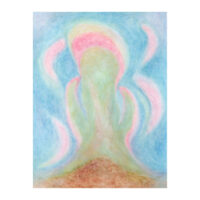Although Rudolf Steiner didn’t give a special meditation for pharmacists, they like to use the meditations he gave to the medical community.
A meditation that I personally like to use in my preparation of medicinal plants—especially when sorting, crushing and mortaring—comes from the fourth lecture in Meditative Contemplation and Guidance for Deepening the Art of Healing (Dornach, January 5, 1924, in Course for Young Doctors, GA316.) There, Rudolf Steiner describes how the physician should cultivate access to nature in order to be able to recognize and apply healing impulses. However, this does not only apply to physicians and pharmacists but to anyone who wants to approach an understanding of nature in a living way. The meditation works with three principles of the plant and the healing spirits working in it. According to Steiner, what the ‘tria principia’ (a concept known to Paracelsus) reveals bodily-physiologically in the plant can also be found in the soul-spirit of the human being.
Nowadays, it is not sufficient to simply recite words of a meditation and expect to advance in knowledge. In the lecture, Steiner points out that the human (the physician) should first consider natural phenomena as intensively as possible. “What is important is to unfold a quite different perception of nature through this medical consciousness. In my young days, I knew a physician whom one often met in the meadows and fields—among the plants and insects and flowers. […] But the work of this unpretentious physician who had such a love for the wildflowers in the meadows was much more fruitful for the sick people than that of the city physician and the other learned men. Their wisdom came from the schools, but his wisdom and understanding of remedies came from that direct intercourse with nature, which leads to a real medical knowledge when we can love nature, in all her details. […] Therefore it will be a good thing to look, first of all, at the plant world—not because I want to recommend plant remedies for everything, but because much can be learned from the plants, above all for esoteric deepening.”
The meditation given is twofold, in three parts each, and is very stimulating for those who want to practice a living approach to nature. It begins with the sulfuric character of the fragrance of flowers:
You healing Spirits,
you unite
with Sulfur’s blessing
in the ethereal fragrance.
One possibility for working with this is to explore the fragrance of different plants by smelling them and then ‘symbolizing’ their different qualities in color through painting or drawing.
The second part of the verse speaks about the healing spirits active in the vegetative part of the plant and the striving of leaves for the cosmic spherical shape that is expressed in the form of dew drops:
You come to life
in upward springing Mercury,
dewdrop
of growing
and becoming.
Thus, in keeping with Goethe’s concept of metamorphosis, we could immerse ourselves in the growing-flowing element of the plant and imaginatively reflect on the transformation of the leaf form, following the change in shape from the bottom to the top of the plant in our mind.
The last part of the verse is about the healing spirits active in the root:
You come to halt
in the earth Salt
which nourishes the root
in the soil.
For this, we could work with the taste of the salt-absorbing roots and illustrate the qualities graphically.
Only now, enriched with conscious sensory experiences, can we respond inwardly. Steiner offers the second half of the mediation, beginning with the human soul’s response to the sulfur-like fragrance of the plant:
I will unite
the knowledge of my soul
with fire of the blossom’s fragrance.
Then the human soul responds to the cosmic-ideal spherical dewdrops and the transformation of the leaf shapes specific to each plant:
I will bestir
the life of my soul
on the glistening drop of leafy morning.
Finally the human soul responds to the hardening and dissolving tendencies of taste in the saline area of the plant root:
I will make strong
I will make strong
with the all-hardening salt
whereby the earth with loving care
nurtures the root.
Through the sense experience of these three parts of the plant, we can be fired in soul knowledge, enthused in soul life, and strengthened in soul being. Thus, devotion to the spirit world is made possible through loving devotion to the sense world—something quite appropriate for our times.
This meditation was used in one of the 16 working groups during the weekend seminar, Sensory World–Spiritual World, Image and Word in Meditation, held June 2–4, 2023 by the Natural Science Section at the Goetheanum.
Translation Laura Liska













